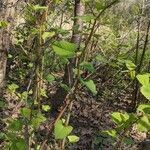Herbs perennial. Rhizomes thickened. Stems numerous, erect, 1-2 m tall, stout, branched above, striate, papillate, often with red or purple spots. Leaves often deciduous; petiole 1-2 cm, papillate; leaf blade ovate or broadly elliptic, 5-12 × 4-9 cm, subleathery, both surfaces glabrous, papillate along veins, base broadly cuneate, rounded, or truncate, margin entire, apex acute or shortly acuminate, not ciliate. Inflorescence axillary, paniculate, 3-8 cm; bracts funnel-shaped, 1-2 mm, oblique, each 2-4-flowered. Pedicels 3-4 mm, slender, articulate below middle. Perianth white or greenish, 5-parted. Male flowers: stamens 8, longer than perianth. Female flowers: 3 outer tepals accrescent and winged on abaxial surface; styles 3; stigmas fimbriate. Achenes included in persistent perianth, black-brown, shiny, ovoid-ellipsoid, 4-5 mm. Fl. Jun-Sep, fr. Jul-Oct. 2n = 44, 52*.
A climbing herb which keeps growing from year to year. It grows 1-2 m tall. The roots are stiff and woody. They are hollow. Young roots have purplish spots on the surface. The leaves grown singly. They are 5-15 cm long by 1-1.5 cm wide. The leaves do not have hairs. The flowers are white. The fruit are triangular shaped.












